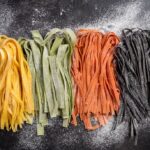How to color pasta naturally
How to make fresh pasta and color noodles with natural color avoiding harmful food dyes in out food.
Yield: 5 people
Cost: 10
Equipment
- 1 pot
Materials
Instructions
How to make coloured pasta - Basic rules to follow
- The added coloring ingredient should not exceed 1/5 of the flour weight.
- Adjust the flour if needed. Some ingredients, like blended vegetables or juices, add extra moisture.
- Knead well for an even color – To distribute the color evenly, knead the dough by hand until the pigment is fully blended.
- Always let the dough rest after kneading. This allows the gluten to relax, making the dough easier to work and helps consistency.
Green Pasta dough
- Use fresh spinach, beets, nettle, mint, basil, or parsley.
- Boil the vegetables, then strain them thoroughly to remove excess water.
- Blend them into a smooth purée and incorporate them into your pasta dough
- Quantity: 2 tsp (6 g approximately) per 1/5 lb of flour (100 g).
Yellow pasta dough
- Saffron (zafferano): half a packet for a delicate golden color on one pound of flour. A single saffron packet (bustina) typically contains 0.15 grams of saffron.
- Turmeric (curcuma): Add 1 tsp per 100 grams (1/5 pound) of flour for a rich, warm yellow.
- Yellow bell peppers: Roast or cook them, then peel and blend. Add one teaspoon at a time to the dough until you reach your desired shade. Drain the cooked peppers before blending to avoid excess moisture.
Orange pasta dough
- Curry or Curcuma (turmeric). Starting from 2 tsp per 100 grams (1/5 pound) of flour.
- Carrots and pumpkin. 50 grams (about 1.75 oz) of carrot per 100 grams (about 3.5 oz) of flour.
Red pasta dough
- Tomato paste, tomato passata. 2 teaspoons of tomato paste for every 300 grams of flour (0.6 pound).
- Paprika, red pepper flakes, or red beets. 30 grams (about 1 oz) for every 100 grams (about 3.5 oz) of flour.
Black pasta dough
- Black squid ink: 2.5 g of squid ink on two pounds of flour.
Brown pasta dough
- Coffee, cocoa powder, or orzo. These ingredients will give your pasta a rich, earthy tone. Start with 1 tsp over one pound of flour and add as you go, working your dough to uniform the color.
Purple fresh pasta
- Cooked beets or purple cabbage. Cook the cabbage with a few drops of lemon juice to keep the color bright. Drain excess liquids and blend. Add one tsp at a time until you get to the desired color tone.
Notes
- If you’re using vegetables, it’s best to boil them first.
- ALWAYS drain the cooked vegetables and strain out any excess liquid, then blend them into a smooth purée before incorporating them into the dough.
- When using liquid natural dyes, reducing the egg quantity is usually necessary.
